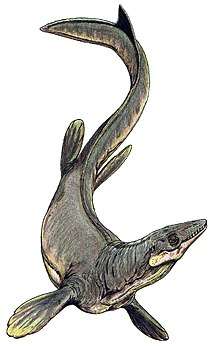Pluridens
Pluridens ("many teeth") is an extinct genus of marine lizard belonging to the mosasaur family. Pluridens is classified within the Halisaurinae subfamily alongside the genera Phosphorosaurus, Eonatator and Halisaurus.[1]
| Pluridens | |
|---|---|
 | |
| Reconstruction of the dentary of P. walkeri. | |
| Scientific classification | |
| Kingdom: | Animalia |
| Phylum: | Chordata |
| Class: | Reptilia |
| Order: | Squamata |
| Superfamily: | †Mosasauroidea |
| Family: | †Mosasauridae |
| Subfamily: | †Halisaurinae |
| Genus: | †Pluridens Lingham-Soliar, 1998 |
| Species | |
| |
Pluridens lived in the shallow seas of West Africa during the late Campanian-Maastrichtian. Two species of Pluridens are known, P. walkeri and P. calabaria. P. walkeri is known from the Maastrichtian of southwest Niger,[2] whereas P. calabaria is found in slightly older (late Campanian) deposits in Nigeria.[3] Pluridens was briefly synonymized with Halisaurus by Lindgren and Siverson (2005),[4] but subsequent studies rejected the synonymy.[1][5]
Description

Pluridens was a moderately large mosasaur at roughly 5 m (16.4 ft) in length if the proportions of the dentary and the rest of the animal matches that of Halisaurus. A feature that separates Pluridens not only from the rest of the Halisaurinae, but from the rest of the Mosasauridae at large is its unusually high tooth count, dentaries assigned to the genus preserve almost twice the amount of teeth found in most other mosasaur genera.[2] Additionally, the dentary of Pluridens also has one of the narrowest profiles among the mosasaurs, with the only genus approaching a similarly narrow dentary being the mosasaurine Plotosaurus.[2] This combination of features indicate a feeding niche and lifestyle unique among the mosasaurs.
The dentary of Pluridens was likely elongated relative to the rest of the head to allow for the massive battery of teeth. Due to force exerted by the lower jaw when biting against the upper jaw would decrease with the distance from the joint, the anterior teeth would have been ineffectual for biting and crushing. During jaw adduction, however, the speed of the anterior teeth could allow Pluridens to swiftly catch and penetrate small soft prey and a large number of teeth would ensure that it did not loose hold of the prey. The tooth crowns are broad and short which indicates that they were used for crushing, perhaps of thinshelled invertebrates. As such, Pluridens was likely a specialist that fed on smaller species of fish that it could swallow whole and thin-shelled molluscs it was capable of crushing. Lingham-Soliar (1998) likened the lifestyle and feeding of Pluridens with that of the ichthyosaurs, particularly early ichthyosaurs such as Temnodontosaurus and Leptonectes.[2]
Lingham-Soliar (1998)[2] listed the following unambiguous character states for the genus: "Very long, slender dentary, anterior half cross-section almost circular extending to tip. Twenty eight-plus teeth in dentary, close-set. Tooth crowns short, no distinguishable carinae, broad, smooth anterior surface, hairline crenations posterior, slightly discernible broad facets, tips posteriorly recurved; teeth virtually uniform in size along most of the dental ramus; replacement teeth emerge medial to mature tooth crowns; resorption pits on mid-lingual side of tooth base".
Classification
The unusually high amount of teeth present in the dentaries of both species of Pluridens initially made it difficult to immediately assign a classification on the subfamily level. Lingham-Soliar (1998) remarked that the unique combination of features (e.g. the high tooth count and a unique tooth shape) would normally result in the creation of a completely new subfamily, but did not create a new subfamily due to the rather fragmentary nature of the remains.[2] Lindgren and Siverson (2005) considered many of the unique features of Pluridens to be shared with Halisaurus and reassigned P. walkeri as "Halisaurus walkeri".[4] The genus synonymy was rejected by later authors, though similarities between the genera and the discovery of distinctly halisaurine vertebrae in Niger allowed the genus to be firmly placed within the Halisaurinae.[1][5] Thus, Pluridens is today considered a highly derived halisaurine.[3]
Species and specimens
The type specimen of P. walkeri is BMNH R14153, an almost complete dentary recovered from the Maastrichtian Farin-Doutchi Formation near Mount Ilatarda, Niger. Lingham-Soliar (1998) also assigned BMNH R9804, a partial dentary with poorly preserved teeth (one out of which is almost complete) from the late Campanian of the Nkporo Formation near Calabar in southern Nigeria, to P. walkeri.[2] The Nigerian specimen BMNH R9804 was reassigned to its own species by Longrich (2016) due to lacking many of the derived features that otherwise characterize P. walkeri, such as not being as elongated or having as large of a tooth battery. The Calabar dentary also lack the extreme lateral protrusion and subcircular section of the dentary and the strong transverse expansion of the dental thecae, both of which are present in BMNH R14153. Longrich (2016) dubbed the new species Pluridens calabaria, which likely represents a direct ancestor to P. walkeri.[3]
References
- Konishi, Takuya; Caldwell, Michael W.; Nishimura, Tomohiro; Sakurai, Kazuhiko; Tanoue, Kyo (2015). "A new halisaurine mosasaur (Squamata: Halisaurinae) from Japan: the first record in the western Pacific realm and the first documented insights into binocular vision in mosasaurs". Journal of Systematic Palaeontology: 1–31. doi:10.1080/14772019.2015.1113447.
- T. Lingham-Soliar. 1998. A new mosasaur Pluridens walkeri from the Upper Cretaceous, Maastrichtian of the Iullemmeden Basin, southwest Niger. Journal of Vertebrate Paleontology 18(4):709-707.
- Nicholas R. Longrich (2016). "A new species of Pluridens (Mosasauridae: Halisaurinae) from the upper Campanian of Southern Nigeria". Cretaceous Research. in press. doi:10.1016/j.cretres.2016.03.013.
- Lindgren J, Siverson M. 2005. Halisaurus sternbergii, a small mosasaur with an intercontinental distribution. Journal of Paleontology 79 (4): 763–773.
- Michael J. Polcyn, Johan Lindgren, Nathalie Bardet, Dirk Cornelissen, Louis Verding, and Anne S. Schulp (2012) Description of new specimens of Halisaurus arambourgi Bardet & Pereda Suberbiola, 2005 and the relationships of Halisaurinae. Bulletin de la Société Géologique de France 183:123-136 doi:10.2113/gssgfbull.183.2.123 http://bsgf.geoscienceworld.org/content/183/2/123.abstract
